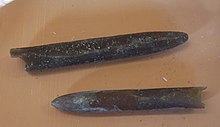| Belemnitella Temporal range:
| |
|---|---|

| |
| Belemnitella americana | |
| Scientific classification | |
| Domain: | Eukaryota |
| Kingdom: | Animalia |
| Phylum: | Mollusca |
| Class: | Cephalopoda |
| Order: | †Belemnitida |
| Family: | †Belemnitellidae |
| Genus: | †Belemnitella d'Orbigny, 1840 |
| Species | |
Belemnitella is a genus of belemnite from the Late Cretaceous of Europe and North America. Belemnitella was a squidlike animal, probably related to the ancestors of modern squids and cuttlefish. The shell was internal. The rostrum or guard is found the most often and possesses a distinctive slit at its ventral surface and a ridge on the dorsal surface. The phragmocone (internal shell) has a small protoconch at its tip, and fit into the cavity and the guard. It also had septa and a ventral siphuncle (tube filled with living tissues running through chambers) within the phragmocone, projecting forward as a beak-like blade.
It had growth layers like tree rings, seen within the cavity of the organism and when the cone is sectioned. The cone was light-brown and glassy in appearance. It is distributed widely in North America. A specimen of a belemnoid had been found in Germany, clearly preserving 10 tentacles as carbon films, showing that belemnoids are similar to squids.[1][2][3]
Belemnitella americana, is the source of the Pee Dee Belemnite, reference standard in research.
- ^ Fossils (Smithsonian Handbooks) by David Ward (Page 163)
- ^ National Audubon Society Field Guide to North American Fossils (Page 536)
- ^ Neal L. Larson; Steven D. Jorgensen; Robert A. Farrar & Peter L. Larson (1997). Ammonites and the Other Cephalopods of the Pierre Seaway. Geoscience Press, Inc. p. 94. ISBN 0-945005-34-2.